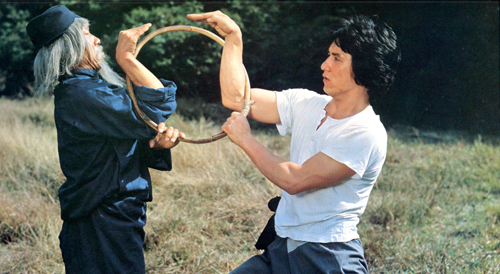By Andrew Hamlin
Northwest Asian Weekly

Jackie Chan in “Snake in the Eagle’s Shadow”
“I don’t think that was Jackie Chan,” I told my movie date, as the lights went up at the end of “Snake In The Eagle’s Shadow.” And I owe her an apology, because it actually was Jackie Chan, who was of course good enough at playing himself that I wondered if he was an imitator. At age 24 in 1978 when “Snake” was shot by first-time director Yuen Woo-Ping, Jackie looked fresh-faced, pliable, and not yet settled into the strict series of charming facial ticks (itchy nose, wide-eyed astonishment, crooked-lipped scoffing) he’d codify later on.
Jackie’s an underdog, as his comic persona usually demands; the strutting masters at his kung fu school find him fit only for floor-scrubbing and abuse, physical and otherwise. His resilience under hostility reminds me of Harold Lloyd’s Speedy character in the “The Freshman,” so desperate to fit in at football that he volunteers as a human tackling dummy. Lloyd did not use a stuntman (neither did Jackie, in 1978). Speedy got up after every tackle, but I wasn’t sure whether to salute him or not. Like Jackie’s character, Speedy could have chosen better friends. But that wouldn’t be funny.
Akira Kurosawa’s “Seven Samurai,” from 1954 (the year Jackie Chan was born) boasts so many piled accolades, saying anything original about it isn’t easy. I took pleasure in one of its quieter moments; I’d remembered when the long-faced, high-cheekboned master swordsman Kyuzo (Seiji Miyaguchi) comes back, through the fog, having silently raided the enemy came and taken a musket. ”Two more down,” he says—and that’s a long speech for him. Then he sits and closes his eyes.
What I hadn’t recalled was the coda to that moment, when youngster Katsushiro (Isao Kimura), rushes over to congratulate Kyuzo and to profess his celestial admiration for the older man. Kyuzo brushes him off. Kyuzo speaks, moves, and kills decisively but simply. He refuses to waste energy. And to borrow a Zen adage, he will sleep when tired. He wants everything, even killing, simple. And direct.
The Cinerama’s print of “Seven Samurai” had some noticeable wear and a recurrent, obnoxious spasm of bright red dots roughly center screen. I learned to look around that red and pay attention to the magnificent black-and-white photography, although it wasn’t easy. The film after “Seven Samurai,” Masaki Kobayashi’s “Harakiri” (1962) showed a little less print wear, although I worried in places that the film would break. I hadn’t seen it on a big screen before, and the widescreen photography brought detail to faces, gestures, stances, intricacies in the film’s many extreme close-ups.
And “Harakiri” chronicles samurai, not their fighting, its big finish notwithstanding. The sacred bushido code, says the story, does not allow for changing times—hard times. It does not allow for empathy, for mercy, for compassion. And in hard times, those with a little power, a little prosperity, scraps of power and prestige—flaunt it, to the suffering of others. The film is set in the seventeenth century; it came out a few years before Stanley Milgram’s “obedience to authority” testing, and several years before the Stanford Prison Experiment, of 1971. And long before the Great Recession.
We don’t need experiments to let us know that the haves close rank and persecute the have-nots, in times of struggle. We only need history. (end)
Andrew Hamlin can be reached at info@nwasianweekly.com.




Nice post. I was checking constantly this blog and I am impressed! Very useful info specially the last part 🙂 I care for such information much. I was seeking this certain info for a very long time. Thank you and best of luck.